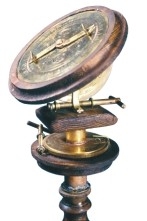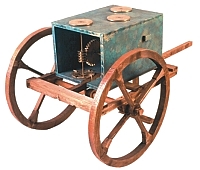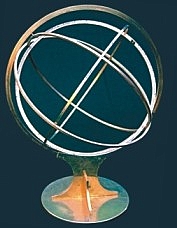FIG Working Week in Athens, May 22-27, 2004
Ancient Greek Technology - Measuring Instruments
During the FIG Working Week and the 27th General Assembly, which will be
held in Athens, (in collaboration with the Association for Ancient Greek
Technology Studies), a short exhibition will be organized, showing some
indicative technical achievements of the Ancient Greece, together with
models of several measuring devices used in topography and astronomy.
- One fundamental aspect of life in ancient Greece, although far less
known, is Technology. A civilisation, however, cannot possibly be
approached without some understanding of the basic social phenomena that
underlie it - and these of course include its economy and its technology.
- Like all social phenomena, technology has its roots in an initial
stage shaped by a great many outside influences. Τhe 6th century BC,
however, something different began to happen in technology as used in
Greece: slowly but steadily a new (and quintessentially Greek) activity,
namely Science, began to impregnate this empirical technology. From this
union would come an abundance of fruits. First of all, technology itself
became more productive (more economical, broader in its application) and
technological innovation easier (rapid technological progress). Second,
with science and technology now working in tandem, a new kind of need
appeared for technology to serve: This was science itself, which needed a
variety of instruments for observation and measurement. These
"technological" products are technology’s return for the gifts it received
from science! In ancient Greece, the multiple links between technology and
science may be observed many times over:
- The empirical techniques used for measuring fields developed into
the science of geometry. The great mathematician Thales of Miletus
was also a fine engineer, who by "diverting the Alis River from its
ancient bed by means of a canal enabled the army of Croesus to cross
over" (Herodotus, I - 75).
- In its turn, the science of geometry became the foundation for a
whole new series of applied sciences, from optics, astronomy and
geography to mechanics and statics.
- There can be no development in technology (nor, for that matter, in
science) without a well-established system of measurements. Distances,
forces and time must all be measurable easily, accurately and precisely;
for without this capability, technique may never progress beyond its
infancy of trial and error. This is why we start by stressing the
importance of methods of measurement, as these were developed in Ancient
Greece and, even more important, as they were used for technical purposes.
Heron’s Dioptra
 The
"dioptra" devised by Heron is a portable surveying instrument for
making accurate geodetic measurements. It measures azimuths, heights,
lengths and angular distances. The
"dioptra" devised by Heron is a portable surveying instrument for
making accurate geodetic measurements. It measures azimuths, heights,
lengths and angular distances.
The apparatus, which was mounted on a tripod about 50 cm tall, pivoted on
a circular plate and was moved around horizontally by a worm screw , driven
by a small handle. The top plate was mounted on a toothed semicircular plate
and was adjusted in the vertical plane by another worm drive. Angles could
be read off the top disc, which was scored with two lines crossing at right
angles. The sighting and reading elements were made of bronze.
Heron’s Odometer
 The
device consists of a set of toothed wheels which, meshed with worm gears,
transmit the movement of a chariot wheel and convert it into units of
length. The three discs on top of the odometer record the distance covered
in units of length. While the chariot is a scale model, the odometer can be
considered as full size, since it can be fitted to a larger vehicle. The
device consists of a set of toothed wheels which, meshed with worm gears,
transmit the movement of a chariot wheel and convert it into units of
length. The three discs on top of the odometer record the distance covered
in units of length. While the chariot is a scale model, the odometer can be
considered as full size, since it can be fitted to a larger vehicle.
This construction was based on the description given by Heron (1st
century BC). The device is autonomous and can be adapted to any wheeled
vehicle.
Astrolabe of Ptolemy
 Claudius
Ptolemaios, mathematician, astronomer and geographer, lived in
Alexandria (2nd c. A.D.). His astrolabe is an astronomical instrument on
which the celestial sphere is projected stereographically. It is used for
the measurement of the geographical longitude and latitude of stars from any
point of the earth. It is also used to measure the distance of the moon from
the sun, as well as for the measurement of the coordinates of the moon
during the day. Claudius
Ptolemaios, mathematician, astronomer and geographer, lived in
Alexandria (2nd c. A.D.). His astrolabe is an astronomical instrument on
which the celestial sphere is projected stereographically. It is used for
the measurement of the geographical longitude and latitude of stars from any
point of the earth. It is also used to measure the distance of the moon from
the sun, as well as for the measurement of the coordinates of the moon
during the day.
Video
Moreover, an animation of 15 min will be shown, describing a historical
technical achievement of a later Greek Engineer (Charburis, 1770):
the transportation of a rock weighing 2000 tones, along a distance of 20 km,
to St. Petersbourg.
T. P. Tassios
Professor Emeritus, National Technical University of Athens
President, Association for Ancient Greek Technology Studies
|

